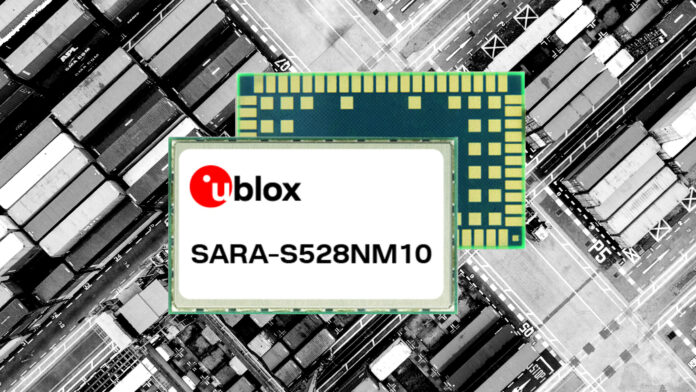Swiss IoT module maker u-blox has launched its first combined terrestrial and non-terrestrial network (NTN; satellite) IoT module, the so-called SARA-S528NM10. It uses the firm’s UBX-S52 dual-mode chipset, offering connectivity via LTE-M and NB-IoT on terrestrial cellular networks and NB-IoT on geostationary orbit (GEO) NTN satellite constellations – as defined by 3GPP in Release 17 of the cellular 5G standard. It works with (“readiness with”) low-Earth orbit (LEO) satellites, too.
The UBX-S52 chipset is currently undergoing certification with satellite IoT connectivity provider Skylo, offering Release-17 level NTN-NB-IoT on existing geostationary satellites. The SARA-S528NM10 module supports all three new NTN bands: the n23 band in the US, the n255 ‘L-band’ globally, and the n256 ‘S-band’ in Europe. It also uses u-blox’s M10 GNSS platform for low-power and concurrent positioning. The unit is pin-compatible with other u-blox cellular-only modules in the SARA form factor – “enabling engineers to easily scale up their IoT products using legacy technology without costly redesigns”, said u-blox.
It is pitching the product to IoT developers of IoT applications that require “continuous or cyclic” tracking and monitoring. Alongside global asset tracking / monitoring solutions, it is going after aftermarket telematics, industrial monitoring and control, smart metering and utilities, and fleet management. In a press note, it quoted ABI Research that the satellite IoT market will exceed $4 billion by 2030, and restated the oft-used in satellite IoT circles statistic that terrestrial cellular networks only cover 10 percent of the planet.
Subscribe now to get the daily newsletter from RCR Wireless News
It stated: “Demand for guaranteed global reach is escalating, particularly for IoT applications such as asset tracking in remote or maritime environments. Satellite IoT bridges this gap; adoption has been partially limited by the high cost of terminals, high power consumption, and high cost of satellite airtime… Current satellite solutions require proprietary hardware and software, which lock the terminal to a specific satellite operator – the user would need to replace their satellite terminals to move to a different operator. The u-blox solution… can be certified as interoperable with multiple satellite providers supporting the standard, maximizing customer choice.”
Stephan Zizala, chief executive at u-blox, commented: “The new u-blox satellite IoT-NTN cellular module is designed to maintain connectivity in areas without cellular coverage. The integrated u-blox GNSS solution consumes less than 15mW of power in continuous tracking mode and has high RF sensitivity that reduces the time required to establish a position fix. It provides concurrent location data without interrupting the cellular or satellite connection, which further helps to minimize power consumption due to the shortened active time of the device.”

